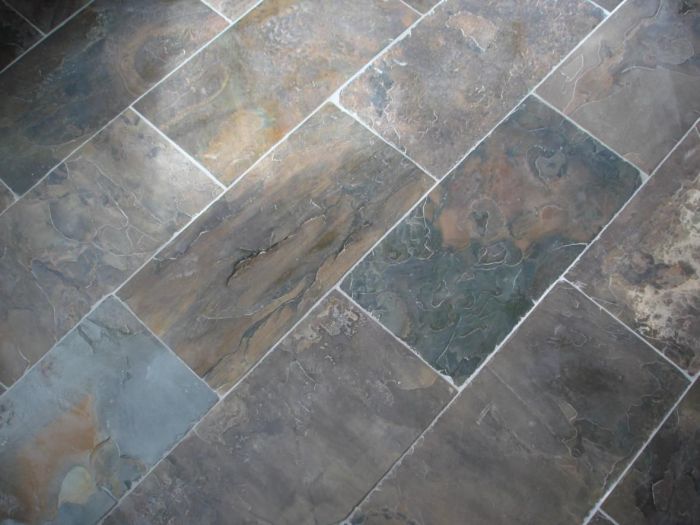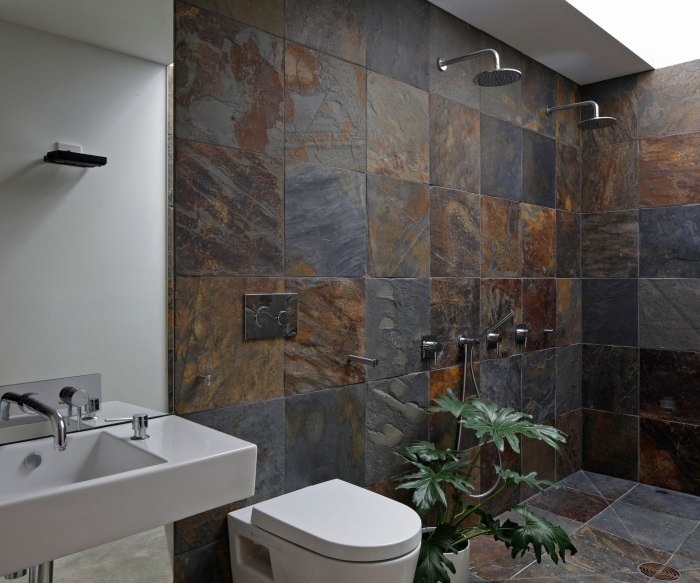Incorporating natural elements into your home decor not only enhances its beauty but also creates a sense of tranquility. Slate bathroom floor tiles are an excellent choice for those seeking a touch of nature in their bathrooms. These tiles, crafted from metamorphic rock, offer a unique combination of durability and aesthetic appeal that can transform your bathroom into a serene and stylish sanctuary.
With their inherent variations in color, texture, and patterns, slate tiles add character and depth to any bathroom design. Their natural cleft or tumbled finishes provide a tactile experience, while honed or polished surfaces create a more refined look. The versatility of slate tiles makes them suitable for a wide range of bathroom styles, from modern to traditional.
Slate Tile Properties and Natural Aesthetics
Slate tiles are a popular choice for flooring due to their unique characteristics and natural appeal. They are formed from metamorphic rock, which gives them a distinctive layered appearance. Slate tiles are known for their durability, low maintenance, and slip resistance.Slate
tiles come in a wide range of colors, including black, gray, green, red, and purple. They also have a variety of textures, from smooth to rough, and patterns, from uniform to variegated. This makes them a versatile option that can be used to create a variety of looks, from rustic to modern.The
finish of slate tiles can also impact their overall look. Honed slate tiles have a smooth, matte finish, while tumbled slate tiles have a more rustic, textured finish. Cleft slate tiles have a rough, natural finish that gives them a unique, organic look.
Design Considerations for Slate Bathroom Floors
Slate tiles offer a unique and natural aesthetic to bathroom floors, but it’s important to consider their advantages and disadvantages before making a decision. Additionally, choosing the right size, shape, and color of slate tiles, as well as considering factors like lighting, grout color, and the overall bathroom design scheme, is crucial for a successful installation.
Advantages and Disadvantages of Slate Bathroom Floors
- Advantages:
- Natural beauty and durability
- Water resistance
- Slip resistance
- Easy to clean and maintain
- Disadvantages:
- Can be cold and hard underfoot
- Prone to scratching and chipping
- May require sealing to prevent staining
- Can be expensive
Choosing the Right Slate Tiles
The size, shape, and color of slate tiles should be carefully selected to complement the style of the bathroom. Larger tiles can make a small bathroom feel more spacious, while smaller tiles can create a more intimate atmosphere. Rectangular tiles can add a modern touch, while square tiles are more traditional.
Slate tiles come in a wide range of colors, from light gray to dark black, so it’s important to choose a color that will complement the bathroom’s overall design scheme.
Other Design Considerations
In addition to the size, shape, and color of the slate tiles, there are other design considerations to keep in mind. Lighting can have a significant impact on the appearance of slate tiles, so it’s important to consider the type of lighting that will be used in the bathroom.
Grout color can also affect the overall look of the floor, so it’s important to choose a color that will complement the tiles and the bathroom’s overall design scheme.
Installation and Maintenance of Slate Bathroom Floors
Installing and maintaining slate bathroom floors requires meticulous attention to detail to ensure durability and longevity. Here’s a comprehensive guide to help you navigate the process:
Substrate Preparation
Proper substrate preparation is crucial for a stable and long-lasting slate floor installation. The subfloor must be flat, level, and free of any imperfections. Any unevenness can cause tiles to crack or shift over time.
Tile Layout
Before laying the tiles, determine the desired layout. Dry-fit the tiles on the floor to visualize the pattern and ensure proper spacing. Use spacers to maintain consistent grout lines and prevent tiles from shifting during installation.
Grouting
Grouting fills the gaps between tiles and provides support. Use a grout that is compatible with slate and follow the manufacturer’s instructions for mixing and application. Apply the grout evenly, pressing it into the joints to ensure complete filling.
Sealing
Sealing the slate tiles is essential to protect them from moisture penetration and stains. Apply a penetrating sealer specifically designed for slate, following the manufacturer’s instructions. Allow ample time for the sealer to penetrate and cure before using the floor.
Maintenance
Regular maintenance is crucial to preserve the beauty and longevity of slate bathroom floors. Here are some common maintenance issues and solutions:
- Efflorescence: White or powdery deposits on the tiles can occur due to moisture penetration. Clean the affected areas with a mild acidic solution, such as vinegar, and rinse thoroughly.
- Stains: Spills and stains can be removed using a poultice made of baking soda and water. Apply the poultice to the stain and let it sit for several hours before removing it with a damp cloth.
- Cracks: Small cracks can be filled with a color-matched epoxy grout. For larger cracks, professional repair is recommended to prevent further damage.
Creative Applications and Design Inspiration
Slate tiles offer endless possibilities for creative expression in bathroom floors. By combining different sizes, textures, and finishes, homeowners can create patterns, borders, and accents that add visual interest and a touch of luxury to their bathrooms.
Innovative Patterns and Accents
Experiment with contrasting shades of slate tiles to create eye-catching patterns on the bathroom floor. Alternating dark and light tiles in a checkerboard or herringbone pattern adds a classic and timeless appeal. For a more modern look, opt for geometric patterns such as hexagons or octagons, using a combination of natural and honed slate tiles.
Borders and Inlays
Incorporate borders around the perimeter of the bathroom floor or create decorative inlays to highlight specific areas. A border of contrasting slate tiles can frame the space and draw attention to the main floor design. Inlays can be used to create focal points, such as a shower area or a freestanding bathtub, and can be made from different materials like marble or wood to add texture and contrast.
Complementary Natural Elements
Slate tiles pair beautifully with other natural elements, such as wood and stone. Combining slate with warm wood accents, such as a vanity or towel rack, creates a cozy and inviting atmosphere. Incorporating stone elements, such as a marble shower wall or a stone countertop, adds a touch of elegance and sophistication.
Final Summary
By considering factors such as tile size, shape, and grout color, you can create a slate bathroom floor that complements your existing decor and enhances the overall ambiance of your bathroom. With proper installation and maintenance, slate tiles will provide years of beauty and functionality, making them an investment that will pay off in the long run.



